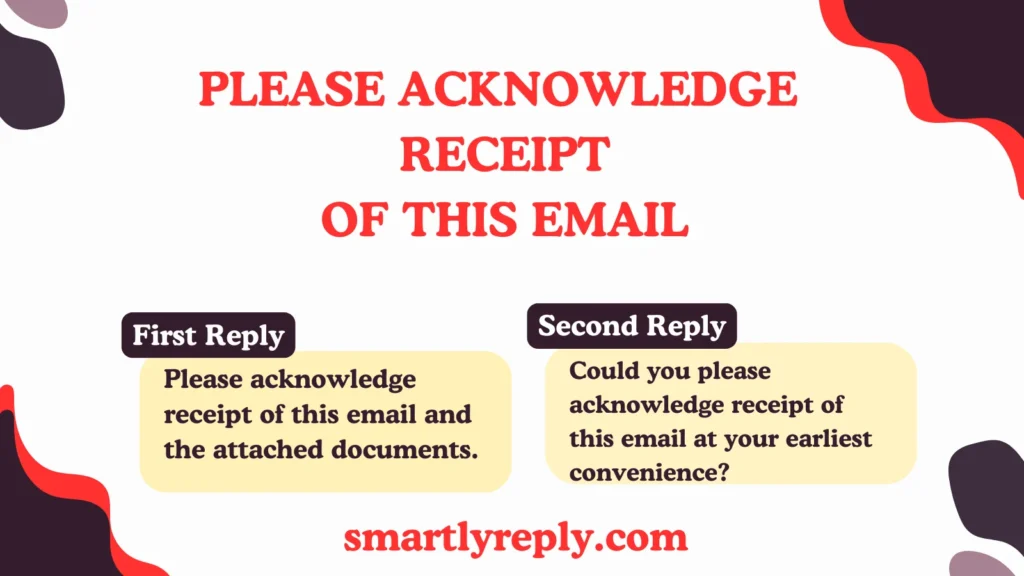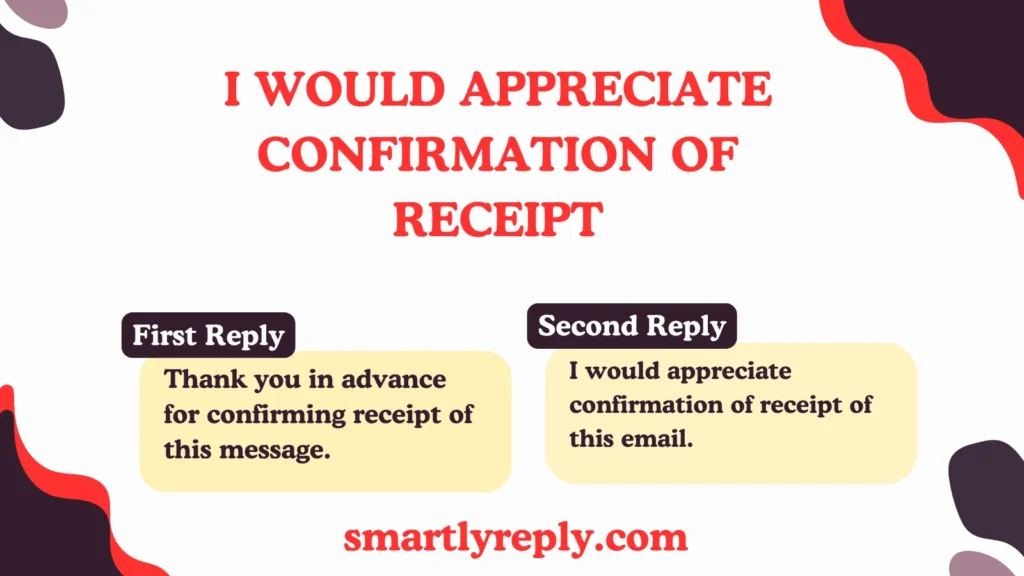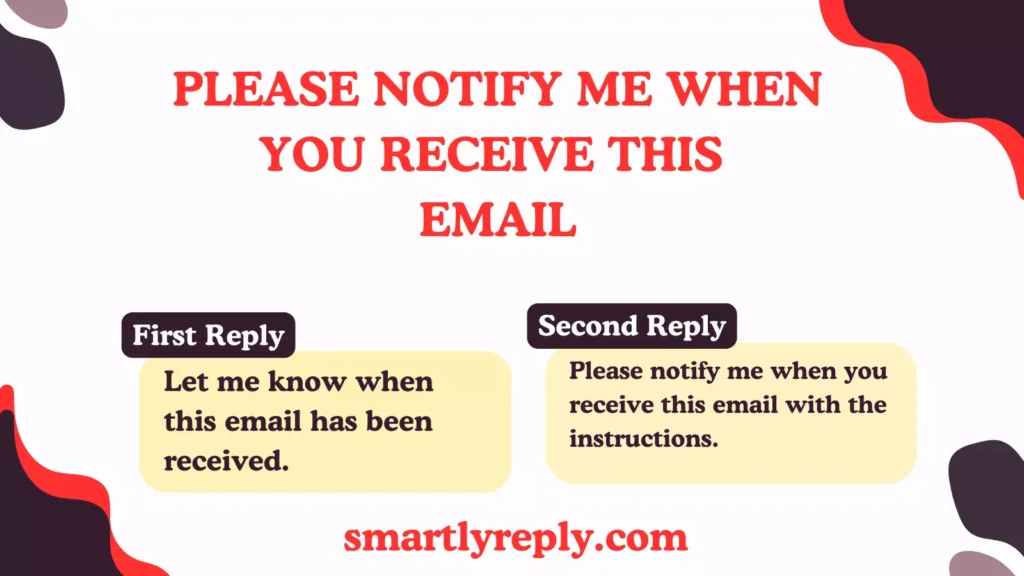Last updated on November 8th, 2024 at 06:39 pm
Last Updated on November 8, 2024 by James Wilson
When you need to ensure that your email has been received, it’s useful to have several ways to request confirmation.
When sending emails, confirming receipt is essential for clarity and professionalism. But saying “Please confirm receipt of this email” can feel repetitive. Here are 20 fresh ways to ask for acknowledgment, helping you maintain a polished tone while ensuring your message is received!
Here are 20 alternatives to “please confirm receipt of this email,” including definitions, scenarios, and examples to help you communicate effectively.
1. “Please Acknowledge Receipt of This Email”

Definition: Requesting that the recipient confirms they have received the email.
Scenario: After sending important documents.
- Example 1: “Please acknowledge receipt of this email and the attached documents.”
- Example 2: “Could you please acknowledge receipt of this email at your earliest convenience?”
2. “Kindly Confirm That You Have Received This Email”
Definition: Politely asking for confirmation of receipt.
Scenario: Following up on an important message.
- Example 1: “Kindly confirm that you have received this email so we can proceed.”
- Example 2: “I would appreciate it if you could kindly confirm receipt of this email.”
3. “Please Let Me Know Once You Receive This Email”
Definition: Requesting notification of receipt.
Scenario: After sending a time-sensitive request.
- Example 1: “Please let me know once you receive this email, as it contains important information.”
- Example 2: “I would be grateful if you could let me know upon receiving this email.”
4. “Could You Please Confirm Receipt of This Email?”
Definition: Asking for confirmation in a straightforward manner.
Scenario: When sending critical instructions.
- Example 1: “Could you please confirm receipt of this email and the instructions provided?”
- Example 2: “Please confirm receipt of this email so I know it has reached you.”
5. “Please Acknowledge This Email Upon Receipt”
Definition: Requesting acknowledgment of the email once it is received.
Scenario: Following up on a request.
- Example 1: “Please acknowledge this email upon receipt so we can ensure it was delivered.”
- Example 2: “I would appreciate it if you could acknowledge this email once you receive it.”
6. “Let Me Know When You Have Received This Email”
Definition: Asking for notification when the email is received.
Scenario: After sending a document for review.
- Example 1: “Let me know when you have received this email with the attached file.”
- Example 2: “Please notify me when you have received this email.”
7. “Please Confirm Receipt at Your Earliest Convenience”
Definition: Requesting confirmation as soon as possible.
Scenario: For urgent communications.
- Example 1: “Please confirm receipt of this email at your earliest convenience.”
- Example 2: “I would appreciate a prompt confirmation of receipt.”
8. “Can You Please Confirm You Received This Email?”
Definition: Asking for confirmation in a casual tone.
Scenario: After sending a follow-up message.
- Example 1: “Can you please confirm you received this email and the attached document?”
- Example 2: “Please let me know if you received this email.”
9. “Please Confirm You Have Received This Message”
Definition: Requesting acknowledgment of the email message.
Scenario: When sending a formal request.
- Example 1: “Please confirm you have received this message and the information within.”
- Example 2: “Could you confirm receipt of this message at your earliest convenience?”
10. “I Would Appreciate Confirmation of Receipt”

Definition: Expressing gratitude in advance for receiving confirmation.
Scenario: After sending a request for feedback.
- Example 1: “I would appreciate confirmation of receipt of this email.”
- Example 2: “Thank you in advance for confirming receipt of this message.”
11. “Please Acknowledge This Message Upon Receipt”
Definition: Asking for acknowledgment of the email once received.
Scenario: After sending important project details.
- Example 1: “Please acknowledge this message upon receipt and review.”
- Example 2: “I would be grateful if you could acknowledge this message upon receiving it.”
12. “Please Let Me Know When This Email Is Received”
Definition: Requesting notification when the email is received.
Scenario: After sending time-sensitive information.
- Example 1: “Please let me know when this email is received so I can ensure it was delivered.”
- Example 2: “I would appreciate it if you could let me know upon receiving this email.”
13. “Please Confirm This Email Has Reached You”
Definition: Asking for confirmation that the email has been delivered.
Scenario: Following up on an important communication.
- Example 1: “Please confirm this email has reached you and the attached documents are accessible.”
- Example 2: “Could you please confirm receipt of this email?”
14. “Please Confirm Receipt of This Email When Possible”
Definition: Requesting confirmation at the recipient’s earliest convenience.
Scenario: When sending a non-urgent but important message.
- Example 1: “Please confirm receipt of this email when possible.”
- Example 2: “I would appreciate it if you could confirm receipt of this email when you have a moment.”
15. “Please Notify Me When You Receive This Email”

Definition: Asking for notification upon receiving the email.
Scenario: After sending detailed instructions.
- Example 1: “Please notify me when you receive this email with the instructions.”
- Example 2: “Let me know when this email has been received.”
16. “Please Confirm That This Email Has Been Received”
Definition: Requesting confirmation that the email has been successfully received.
Scenario: After sending a contract or important document.
- Example 1: “Please confirm that this email has been received and the attachment is accessible.”
- Example 2: “I would appreciate confirmation that this email has been received.”
17. “Please Let Me Know Once This Email Reaches You”
Definition: Requesting notification when the email reaches the recipient.
Scenario: When sending a request for action.
- Example 1: “Please let me know once this email reaches you and if any action is required.”
- Example 2: “I would appreciate it if you could let me know once you receive this email.”
18. “Could You Please Confirm Receipt of This Message?”
Definition: Asking for confirmation in a polite and formal manner.
Scenario: After sending a request for feedback or approval.
- Example 1: “Could you please confirm receipt of this message and any feedback you may have?”
- Example 2: “Please confirm receipt of this message at your convenience.”
19. “Please Acknowledge Receipt of This Message”
Definition: Requesting that the recipient confirms they have received the message.
Scenario: Following up on an important announcement.
- Example 1: “Please acknowledge receipt of this message and the attached files.”
- Example 2: “I would appreciate it if you could acknowledge this message upon receiving it.”
20. “Please Confirm That You Have Received This Email”
Definition: Asking for confirmation that the email was received.
Scenario: After sending a detailed update.
- Example 1: “Please confirm that you have received this email with the updated details.”
- Example 2: “I would be grateful if you could confirm receipt of this email.”
FAQs
Q1: Why is it important to ask for confirmation of email receipt?
A1: Asking for confirmation ensures that the recipient has received your email and acknowledges its contents. This is especially crucial in business communications or when sending time-sensitive information. It helps maintain clear communication and prevents misunderstandings.
Q2: What are some polite alternatives to saying “Please confirm receipt of this email”?
A2: You can use phrases such as:
- Kindly acknowledge receipt of this message
- Please let me know once you’ve received this email
- Can you confirm if you received this email?
Q3: When should I ask someone to confirm receipt of my email?
A3: You should ask for confirmation when sending important documents, contracts, or instructions where receiving acknowledgment is necessary. It’s also useful for follow-up emails or when a response is expected within a certain timeframe.
Q4: How do I politely request confirmation without being too formal?
A4: A casual request like “Just checking if you got this!” or “Let me know if this reached you!” maintains politeness without sounding overly formal. It’s ideal for more informal business relationships or internal team emails.
Q5: Can these alternatives help with email response rates?
A5: Yes! Asking for confirmation using different phrases can make your request clearer and more likely to get a response. It shows professionalism and respect for the recipient’s time.
Conclusion
In professional communication, clear and polite requests for confirmation help ensure that your message has been received and understood.
By varying your phrasing, such as using “Could you please acknowledge this email?” or “Kindly confirm receipt at your earliest convenience,” you can avoid sounding repetitive while still being courteous and effective.
These alternative phrases allow you to maintain a professional tone and enhance communication clarity. Experiment with different wording to find what best suits your style and audience, but remember, politeness and clarity are always key!











